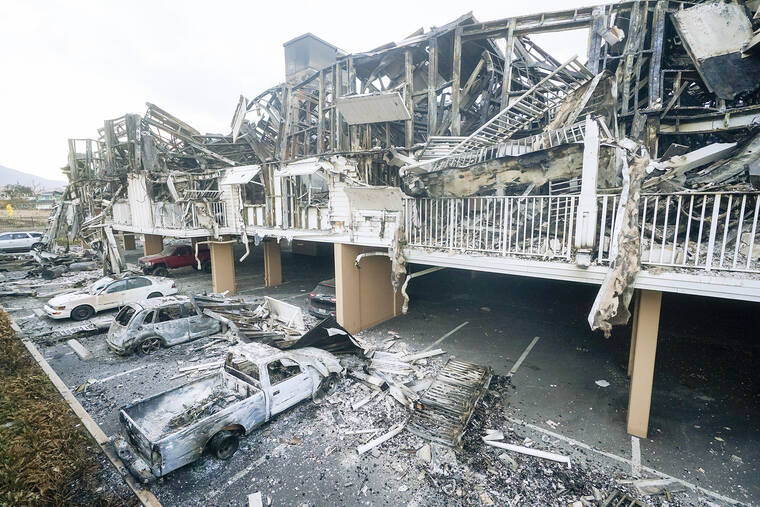Hawaii economists say Lahaina locals could be priced out of rebuilt town without zoning changes
HONOLULU — Residents who survived the wildfire that leveled the Maui town of Lahaina might not be able to afford to live there after it is rebuilt unless officials alter the zoning laws and make other changes, economists warned Friday.
“The risk is very real,” Carl Bonham, executive director of the University of Hawaii Economic Research Organization, told a virtual news conference ahead of the group’s release Friday of its quarterly state economic forecast.
ADVERTISING
Soaring housing prices have already forced many Native Hawaiians and other longtime Hawaii residents to leave the islands and move to the U.S. mainland. The wildfire that claimed at least 97 lives and destroyed 2,200 buildings in the West Maui community of Lahaina — 86% of which were residential — amplifies that problem for the survivors. Nearly 8,000 of them have been placed at 40 hotels or other accommodations around the island of Maui.
“Market prices for this new housing are likely to far exceed the already high prices that existed in Lahaina before the fire. For renters, the old housing stock that was destroyed provided opportunities for reasonable rents,” the economic report said.
A spike in housing costs would be a further burden for people — including retirees and those who worked in restaurants, hotels and shops — who lost their homes and jobs when their places of employment burned to the ground on Aug. 8, or when West Maui temporarily closed to tourism after the disaster.
West Maui, where the verdant coastline is studded with resort hotels, will reopen on Oct. 8.
“You’ll see that that will speed our recovery for those who have suffered so much,” Gov. Josh Green said.
At a news conference on Thursday at the state Capitol, Green stressed that the displaced survivors won’t be forced out of hotels to make room for tourists, with October typically being a slow month for tourism.
But it is much less clear when people displaced by the fire will be able to move back to Lahaina and whether they’ll be able to afford to do so. Bonham said he doubts that rebuilding will start before 2025.
The warning about locals being priced out of a rebuilt Lahaina, which was once the capital of the former Hawaiian kingdom in the 1800s, comes despite Green’s assurances that he won’t let it get too expensive for locals. Green previously indicated that he was considering having the state acquire land for workforce housing, but he later said that wouldn’t happen unless the community requested it.
On Aug. 19, Green banned unsolicited offers for property in Lahaina to prevent land from being snapped up by deep-pocketed outsiders. He said his administration has opened several investigations into alleged violations of that emergency proclamation.
Some Lahaina residents have said that Green should have imposed an outright ban on purchasing property.
“Outsiders should not have the opportunity to grab land or properties because emotions are running high, so everyone is vulnerable,” Melody Lukela-Singh, whose home on Lahaina’s renowned Front Street burned, said recently.
Bonham said policy changes and a concerted effort are needed to prevent a rebuilt Lahaina from becoming a haven exclusively for the wealthy, for example by changing zoning to allow smaller and more affordable housing units like duplexes and apartments.
“We need to be seriously focusing on multifamily housing,” he said. “That’s the way you get housing that isn’t million dollar-plus homes: You’ve got to have more density.”
Currently, only about 1% of the land in Lahaina’s burn area is zoned for multifamily housing, Bonham said.
The new economic report said the post-disaster plunge in tourism to Maui has hit the island’s economy and people hard.
Officials initially told prospective tourists to stay away from Maui. Visitor arrivals dropped by nearly three-quarters, the report said. In the weeks after the fire, Maui lost more than $13 million per day in visitor spending.
With businesses lacking customers, layoffs resulted.
In July, the unemployment rate on Maui was only 2.6%. But it will soar above 11% in the next three months, the economists predicted. It’s not expected to dip below 4% until late 2026.
There have been about 12,000 new unemployment insurance claims filed since the disaster — about 11,300 more than before the fire.
The U.S. Department of Labor extended the application filing deadline for Disaster Unemployment Assistance by one month, through Oct. 16, Hawaii’s Department of Labor and Industrial Relations announced on Friday.
“Individuals that do not qualify for regular unemployment insurance may be eligible for DUA benefits,” Green said.
Officials are now beckoning tourists to come to Maui.
The report said the planned Oct. 8 reopening of West Maui resort areas will restart tourism in the region, with a gradual recovery.
By the end of this year, Maui visitor arrivals are expected to be roughly half of the 2022 level, rising to 80% by the end of 2024.


